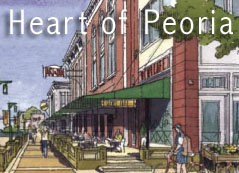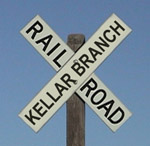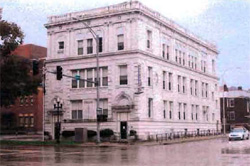According to our neighborhood newsletter, second-district councilperson Barbara Van Auken is not going to ask for any funding for Main Street improvements in 2009:
The proposed changes to Main Street are estimated to be in the order of $10 million. Barbara Van Auken (our City Council representative) will not support inclusion of changes to Main Street in Peoria’s 2009 budget, citing the need to do further study of the project, as well as more pressing priorities elsewhere in the city for next year’s capital budget.
That’s right. After all the time, money, and effort that has been expended for these improvements over the past six years, now, at the 11th hour, our city councilperson is evidently going to abandon the project.
Let’s review. Main Street is one of four form districts in Peoria (the others being the Warehouse District, Sheridan/Loucks Triangle, and Prospect Road Corridor). A form district is a small part of the Heart of Peoria Plan area that the City singled out for more intensive coding known as a “form-based code.” The idea was to focus resources on these areas, then spread out from there to revitalize the rest of the Heart of Peoria Plan area over time.
Main Street is starting to see some significant private investment. The old Walgreens was recently purchased and a new mixed-use development is underway. The businesses adjacent to the Costume Trunk are replacing their facade. One World recently expanded with the departure of Lagron Miller.
But at least one established business — Running Central — is getting impatient for improvements to be made to Main Street. In the past, the new owner has stated that if changes aren’t made, he’s going to move the business to Junction City.
You can’t blame him. The city seems to be stuck in “analysis paralysis” when it comes to changing the streetscape on Main. Consider the studies: The Heart of Peoria Plan (2002); Wallace Roberts & Todd Med-Tech/Ren Park study (2004); Farrell-Madden form-based code study (2006); Hansen traffic study (2008). All of these studies in one way or another said we need to “fix the streets” — i.e., make them more pedestrian-friendly, slow the traffic down, provide on-street parking for businesses, etc. — and so far, no road improvements have materialized.
Van Auken’s pronouncement that she won’t even try to get funding for this important project in 2009 is disappointing to say the least. After six years and four studies on this project, what’s it going to take to get some follow-through from the city?
In fairness, some progress has been made in other areas: specifically, the form-based code and broader Land Development Code have been enacted. But that’s only half of what’s needed to make these form districts a success. The LDC and form-based codes regulate the private space. But in order for these districts to thrive, there absolutely must be improvement to the public space as well.
Public improvements have been noticeably absent from the form districts so far. Attempts to make Adams and Jefferson street two-way in the Warehouse District has met with opposition from Caterpillar. Efforts to narrow Washington street to make it more pedestrian-friendly has met with opposition from IDOT and first district councilman Clyde Gulley, who is in the trucking business and likes having Washington be a high-speed truck route. The Prospect Road corridor hasn’t even been talked about the last two years.
The most promising area is the Sheridan/Loucks Triangle, where yet another study has recently been done to look at specific ways to improve the streetscape. Whether that effort will get funded remains to be seen. I’m not sure whether Van Auken considers it one of those “more pressing priorities” for the City’s capital budget, or if it will also get the axe.
Finally, let’s quickly talk about Van Auken’s reasons for abandoning the Main Street project.
- “The proposed changes to Main Street are estimated to be in the order of $10 million.” — Assuming that estimate is correct, yeah, that’s a lot of money. But of course it can and should be phased over several years, not spent all at once. That’s the way it is with all large road projects. Speaking of which, does anyone think that the fifth district councilman will not ask for funding for widening Northmoor Road or extending Pioneer Parkway in 2009 due to “more pressing priorities elsewhere in the city”?
- “…citing the need to do further study of the project…” — I think we’ve already established that there’s been plenty of study. Anyone wanting more study at this point is simply looking for different conclusions.
- “…as well as more pressing priorities elsewhere in the city for next year’s capital budget.” — Why is the Main Street project not a “pressing priority”? We’ve spent hundreds of thousands of dollars studying it and countless hours getting public input on it. There’s even a grassroots organization (Campaign for a Walkable West Bluff) that has sprung up to try and push this project along. There’s no governmental or judicial agency standing in the way of it. It’s part of the city’s plan for revitalizing the older parts of town. What are these unspecified “more pressing priorities”? Implementing a new logo? Continuing to subsidize downtown parking?
I would also point out that these improvements to Main Street have quite a bit of popular support in the second district (although there are some who are opposed, of course). Neighborhood organizations, the West Bluff Council, and businesses along Main are pretty enthusiastic about seeing these changes made. I wonder how all those people will feel about Van Auken putting the kibosh on those improvements right before she’s up for reelection.

 The city’s Planning and Growth Department is spearheading an effort to review the portion of the Land Development Code (LDC) that deals with form-based code districts “to determine if all the regulations are performing as anticipated and to ensure compatible development which meets the purpose statements of the code.” Toward that end, they have done two things:
The city’s Planning and Growth Department is spearheading an effort to review the portion of the Land Development Code (LDC) that deals with form-based code districts “to determine if all the regulations are performing as anticipated and to ensure compatible development which meets the purpose statements of the code.” Toward that end, they have done two things: As my
As my  The verdict is in: A side-by-side rail with trail on the Kellar Branch corridor is indeed feasible, and it only costs about 2/3 what the Peoria Park District estimated.
The verdict is in: A side-by-side rail with trail on the Kellar Branch corridor is indeed feasible, and it only costs about 2/3 what the Peoria Park District estimated. Thanks to the kindness of City staff members in the City Clerk and Planning & Growth departments, I was able to get a copy of the historic preservation application for the AMVETS building:
Thanks to the kindness of City staff members in the City Clerk and Planning & Growth departments, I was able to get a copy of the historic preservation application for the AMVETS building: